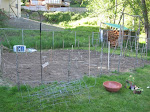a model of what it looked like
this move we watched during the tour also showed what it
would have looked like
There are archaeological digs all over the area...
One excavation uncovered a stepped-stone structure that dates from before the 10th-century BC. It is believed that this was a retaining wall for either David's palace or the Jebusite fortress. When Solomon built the Temple, homes for the wealthy or political dignitaries were built here...
The ruins of this house contained housewares and cosmetics from the ruins of 586 BC. Even a limestone toilet seat was found in the 2-story ruins.
Water from the Gihon was always crucial to the survival of the city. The Jebusites had guard towers built and dug tunnels to channel the water. Later, in the 7th century BC, King Hezekiah dug a new 1750-foot tunnel to bring water to the Pool of Siloam inside the city to prepare for a siege by the Assyrians. (2 Kings 20:20) Visitors can walk some of the underground water system, now called Warren's Shaft. It is named after the British engineer, Charles Warren, who discovered it in the 1860s.
a jar embedded into the rock
some parts are pretty deep
watching a movie about the history of the City
At the end of the tour, we had the option to take the dry Canaanite tunnel or wade through Hezekiah's Tunnel. Chris and I came prepared and took the watery route back...
Turned out it was also the noisy route, as we were behind a large group of 12-year old schoolboys...
click on the videos twice to hear and see what it was like...
I was sure glad we bought new headlamps just for this purpose. They worked great!
Some people from our group were waiting for us when we emerged to make sure we survived... LOL



































































